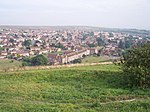Bevendean

Bevendean is a district of the city of Brighton and Hove, in East Sussex, England. The estate lies to the north-east of central Brighton, and was largely developed after World War II with a mixture of council housing and private development. A large proportion of the council houses are now privately owned. The area has limited local facilities and there is only one road access route into and out of the area. The manor of Bevendean was recorded in the Domesday Book of 1086. The name is derived from 'Beofa's valley'. It was later divided into two estates, Upper Bevendean on the hill and Lower Bevendean in the valley. Some housing development began in the 1930s, with the population expanding rapidly from 1948 onwards. An industrial estate was developed from the mid-1950s.The two local churches are: the Church of the Holy Nativity, built in 1963 as a Modern-style building in brick by architect Reginald Melhuish, ARIBA, and The Salvation Army - which occupies a building that was previously a baptist Chapel built around 1950s. The local school is Bevendean Primary School, a community school that educates children from the range of 3 to 11. The Bevy opened on 12 December 2014 making it the first co-operative pub on a housing estate in the UK.
Excerpt from the Wikipedia article Bevendean (License: CC BY-SA 3.0, Authors, Images).Bevendean
Heath Hill Avenue, Brighton Bevendean
Geographical coordinates (GPS) Address Nearby Places Show on map
Geographical coordinates (GPS)
| Latitude | Longitude |
|---|---|
| N 50.8414 ° | E -0.1021 ° |
Address
Heath Hill Avenue 46
BN2 4FH Brighton, Bevendean
England, United Kingdom
Open on Google Maps









